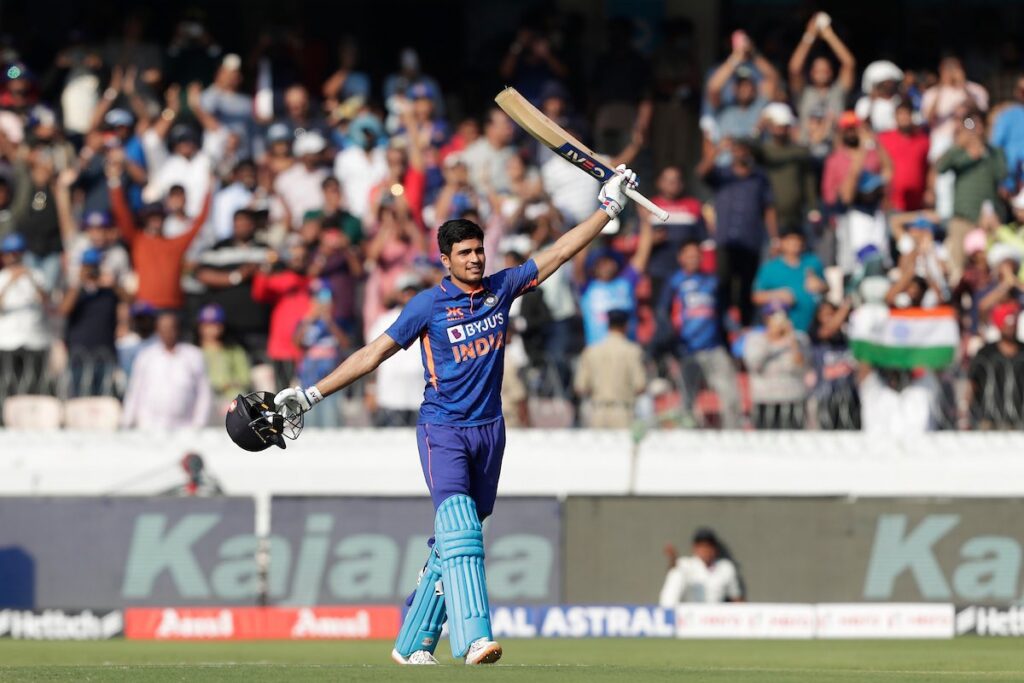As both Rohit Sharma and Virat Kohli could tell you, form in the months leading up to a World Cup is everything, and Gill seems to be timing his final sprint perfectly.
With batting, as in life, timing is everything. From the time he caught the eye as an Under-19 cricketer, we’ve known that there’s little wrong with how sweetly the ball leaves Shubman Gill’s bat when he’s in good nick. Till very recently though, Gill was very much on the fringes of India’s planning for the 2023 World Cup. But suddenly, after two centuries and a 50 in his last four ODIs, including the epic 208 in Hyderabad on January 18, Gill has made a compelling case to be part of the 15-man squad. As Virat Kohli, one of those Gill grew up wanting to emulate, could tell you, that kind of timing is just as vital as the precise moment when bat meets ball.
The planning for a World Cup starts pretty much as soon as the previous one is over. The selectors will first identify a core group that they think will still excel in four years’ time. After that, they will try out various permutations and combinations, with young hopefuls and those on the comeback trail all given chances. Since the 2019 World Cup, for example, India have flirted with both the unproven talent of Ravi Bishnoi and the vast experience of Ravichandran Ashwin, part of the winning squad at the 2011 World Cup and the 2013 Champions Trophy.
But with less than a year to go for the tournament now, you’ll see less and less by way of experimentation. Bowlers will be rested and rotated to keep them fresh, especially the quicks, but the chances are that the batting line-up that does duty in most of the home ODIs this season will be the one that India look at when the World Cup starts later in the year.
Gill’s recent run of form will have summoned up very contrasting memories for two of the team’s stalwarts. Rohit Sharma was marked for greatness long before Kohli, and was part of the initial rebuild after the 2007 World Cup debacle in the Caribbean. His partnership with the great Sachin Tendulkar as India won the Commonwealth Bank Series in Australia in 2008 hinted at his rich promise, and Rohit played 61 matches in the years leading up to the 2011 World Cup on home turf.
Kohli only made his debut in 2008, and had just 15 caps to his name by the end of 2009. He made his first ODI century around that time, at Eden Gardens, but was far from being a lock for the World Cup squad. When the team went to Zimbabwe for a tri-series featuring Sri Lanka as well in May 2010, it was Rohit that started the stronger with back-to-back hundreds.
Remember too that Rohit and Kohli were both scrapping for a middle-order spot at the time. With Tendulkar, Virender Sehwag and Gautam Gambhir in the fray, the top 3 was a closed shop. The first two names roll off the tongue easily when India’s batting legends are named, so it’s easy to forget that it was Gambhir that played the most important ODI innings by an Indian this century, the 97 in the 2011 final against Sri Lanka.
Suresh Raina and Yuvraj Singh offered left-handedness and part-time bowling options, leaving Kohli and Rohit to tussle for the final spot in a batting order that also had MS Dhoni. After his twin hundreds in Zimbabwe, though, Rohit crossed 50 just once in 16 innings. That miserable run culminated in just 49 runs in a series in South Africa, India’s final tune-up before the big event. In the same period, Kohli reeled off five half-centuries and brilliant hundreds against Australia and New Zealand. By the time the South Africa series was over, with Kohli tallying 193 runs, the selectors had a relatively straightforward decision to make.
With Rishabh Pant unlikely to be part of the equation now, India’s top six for the World Cup has just two vacancies left. Rohit will captain and open, with Kohli at No.3. Unless he suffers a massive slump in form over the next few months, Shreyas Iyer has done enough to take the No.4 slot. Hardik Pandya, provided he stays fit, must bat at No.6 to lend the side the sort of balance Yuvraj was able to give in 2011.
That leaves the second opening slot, and a middle-order berth that doubles up as the wicketkeeper. KL Rahul and Ishan Kishan are in contention for that, with both also capable of opening. Suryakumar Yadav, who hasn’t yet been able to carry his sparkling T20 form into the ODI arena, is another in the mix. In a sense, it’s SKY that Gill is competing with. Both Rahul and Kishan are likely to be in the 15-man squad, with one as the back-up wicketkeeper/opener.
What Gill showed against a far from toothless New Zealand attack was that this is the format he is currently most comfortable in. In Tests, there are still frailties that teams will target, and in T20s, he hasn’t quite mastered the hit-hit-hit tempo. In 50 overs, with a little more breathing room to find your rhythm, he looks a serious player.
As with Kohli back in 2010, Gill seems to be timing his final sprint perfectly. Four years of intense work goes into any World Cup, but recency bias plays a huge part in squad selection. Right now, Gill is very much in pole position to open alongside Rohit at the World Cup. As if he bats like he did in Hyderabad, the selectors won’t be taking a risk at all.




